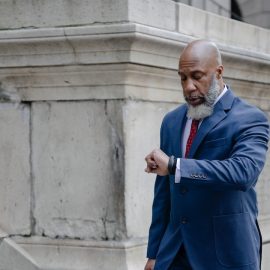

This article is an excerpt from the Shortform book guide to "The Advantage" by Patrick Lencioni. Shortform has the world's best summaries and analyses of books you should be reading.
Like this article? Sign up for a free trial here.
What is leadership team development? What does a leadership team do?
A leadership team is a group of people who are responsible for establishing and pursuing company goals. In The Advantage, Patrick Lencioni suggests building this team under five standards that they should uphold.
Let’s look at these five standards and how they contribute to your leadership team development.
Creating a Unified Team With Leadership Team Development
Lencioni explains that organizational health starts at the top, so you must begin by creating a unified and efficient leadership team. This team should ideally be composed of three to nine individuals who’ll share responsibility for establishing and achieving organizational goals. Each of these individuals should represent a crucial part of the organization or provide a unique, valuable perspective to the team. The team should be able to come to collective decisions after meaningful discussions and debates.
To support leadership team development, Lencioni explains that the team must establish five standards: safety, advocacy and debate, unanimous dedication, specialized roles, and the ability to hold each other responsible. Let’s explore each standard in detail.
Standard #1: Build a Safe Environment
Lencioni explains that building a safe environment in which members trust and understand each other is the foundation of a unified and effective team. Safety allows members to admit shortcomings, hold others accountable, have disagreements, ask for help, and share praise.
To build safety among team members, Lencioni recommends holding an off-site meeting where members:
1) Share personal stories explaining the major parts of their life thus far—where they were born, what their family dynamic was, their personal interests, and the hardships and accomplishments they’ve faced in their life. This will give members a better understanding of each other’s behavioral tendencies and values. For example, you might realize that one member is sensitive to conflict because they grew up in a dysfunctional household.
2) Take a personality test, like the Myers-Briggs Type Indicator, and share their results with the team. This will give members insight into their peers’ likes, dislikes, communication styles, and so on, and will improve collaboration.
3) Learn about the fundamental attribution error—a human trait that makes us more likely to unfairly judge others. The fundamental attribution error states that people tend to blame others’ negative behaviors on personal factors like their desires or traits, whereas we blame our own bad behavior on external factors (thereby absolving ourselves of responsibility). For example, you’re likely to blame a colleague’s outburst on their bad attitude but blame your own outburst on a stressful situation. However, if members understand each other (the purpose of the previous two activities in this list), they’ll be less likely to engage in the fundamental attribution error and level personalized blame, thereby creating a safer environment.
(Shortform note: In Crucial Accountability, the authors explain that making the fundamental attribution error during accountability conversations can spell disaster for professional relationships, and as Lencioni explains, diminish safety. However, rather than simply building mutual understanding between members and hoping it prevents the error as Lencioni suggests, the authors of Crucial Accountability recommend a specific strategy for avoiding it: Before forming opinions about someone’s actions or intentions, consider all of the personal, social, or environmental factors that might have influenced their behavior.)
Standard #2: Encourage Advocacy and Debate
Next, Lencioni explains that leadership team development must encourage advocacy and debate to make effective decisions. Each member of the leadership team should feel comfortable advocating for their ideas. Without discussing the merits and pitfalls of each suggestion and engaging in disagreements, it’ll be impossible to determine the best idea.
Lencioni notes that establishing a safe environment that also encourages conflict is difficult because people want to avoid hurting each other’s feelings. To establish this environment, the leader of the organization needs to set an example—encourage everyone to speak up and show the group that disagreements can be addressed productively and respectfully. Leaders must scan the room for points of conflict during meetings, bring them to the group’s attention, and open a respectful discussion.
For example, imagine the team is discussing where to allocate excess funds this quarter, and one member suggests putting it towards charity. While some members agree, others remain silent and look hesitant. The leader should notice and address this conflict by encouraging advocacy and debate—asking members to explain why they disagree and to propose alternative suggestions.
Standard #3: Establish Unanimous Decisions and Priorities
Further, Lencioni says that every member must be fully dedicated to team decisions and organizational priorities for the leadership team to be effective. If even one member of the team lacks dedication or denies responsibility, they could end up sabotaging productivity and dividing the team with politics (conflict regarding responsibilities and power).
To foster dedication, the leader must ensure that everyone agrees on, or at least understands, the merits of a decision before it’s made—there should be no “majority rules” decisions. Members may debate each other but should unanimously agree on the best course of action before a meeting concludes. This is only possible in teams that have mutual trust and encourage and tolerate conflict.
Additionally, members must prioritize and share responsibility for the organization’s goals. Many leadership teams are made up of members who run different departments, such as sales, transportation, marketing, and so on. Each of these members will have individual and departmental goals; however, the current goals of the organization as a whole must be their top priority. For example, if the company’s quarterly goal is to increase sales by 5%, every member of the leadership team should help achieve this goal, not just the person in charge of sales.
Standard #4: Develop Specific Roles
Lencioni explains that effective leadership teams must designate each member a specific role based on their expertise. The team should then divide important tasks between members based on their roles. This will increase efficiency by ensuring that all necessary tasks are accomplished and no two people end up working on the same thing.
Further, without a division of labor, politics and disorganization are likely to arise. For example, one member may spread themselves too thin by getting overly involved in another member’s department. This could cause frustration for the other members (politics) and slow down progress in both departments (disorganization).
(Shortform note: Experts agree that clearly defining team roles and responsibilities is key for productive and effective organizations. However, they add a few extra recommendations to help create effective roles that people enjoy working in. First, ask members about their long-term goals and try to assign them roles and responsibilities that will help them to accomplish those goals. Next, give members complete ownership over their roles—showing members that you trust them to get their tasks done without looking over their shoulder will provide them with motivation and encourage them to take initiative.)
Standard #5: Hold Each Other Responsible
Finally, Lencioni explains that to support leadership team development, team members must be comfortable directly holding each other responsible for their work rather than asking the leader to enforce accountability. This means confronting someone if they stray from their commitments or are hindering progress, even if they’re doing it unintentionally. This will maintain unity and encourage dedication among team members because they know they’ll be held accountable for their efforts.
To get into the practice of holding each other accountable, Lencioni recommends that team members write down one beneficial thing that each member does and share their responses. Then, have everyone write one thing each person does that might hurt the team and have everyone share their responses. By discussing the positives before the negatives, team members will feel more comfortable being transparent with each other for the benefit of the team.

———End of Preview———
Like what you just read? Read the rest of the world's best book summary and analysis of Patrick Lencioni's "The Advantage" at Shortform.
Here's what you'll find in our full The Advantage summary:
- How the biggest business advantage you can gain is free and within your reach
- How to create an effective leadership team
- How to maintain organizational health with effective meetings






